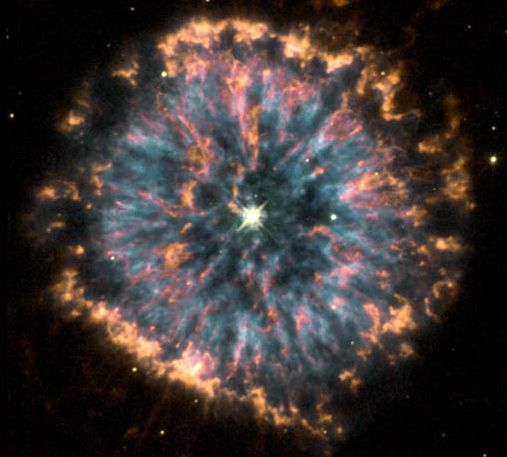
|
Explanation: Planetary nebulae can look simple, round, and planet-like in small telescopes. But images from the orbiting Hubble Space Telescope have become well known for showing these fluorescent gas shrouds of dying Sun-like stars to possess a staggering variety of detailed symmetries and shapes. This composite color Hubble image of NGC 6751 is a beautiful example of a classic planetary nebula with complex features. It was selected in April of 2000, to commemorate the tenth anniversary of Hubble in orbit. The colors were chosen to represent the relative temperature of the gas - blue, orange, and red indicating the hottest to coolest gas. Winds and radiation from the intensely hot central star (140,000 degrees Celsius) have apparently created the nebula's streamer-like features. The nebula's actual diameter is approximately 0.8 light-years or about 600 times the size of our solar system. NGC 6751 is 6,500 light-years distant in the high-flying constellation Aquila.
|
January February March April May June July August September October November December |
| ||||||||||||||||||||||||||||||||||||||||||||||||
NASA Web Site Statements, Warnings, and Disclaimers
NASA Official: Jay Norris. Specific rights apply.
A service of: LHEA at NASA / GSFC
& Michigan Tech. U.
Based on Astronomy Picture
Of the Day
Publications with keywords: NGC 6751 - HST - planetary nebula
Publications with words: NGC 6751 - HST - planetary nebula
See also:
- APOD: 2025 April 15 Á Planetary Nebula NGC 1514 from Webb
- Planetary Nebula Abell 7
- The Medusa Nebula
- Jones Emberson 1
- APOD: 2024 February 12 Á HFG1 & Abell 6: Planetary Nebulae
- APOD: 2023 December 24 Á NGC 2440: Cocoon of a New White Dwarf
- APOD: 2023 October 3 Á MyCn 18: The Engraved Hourglass Planetary Nebula
